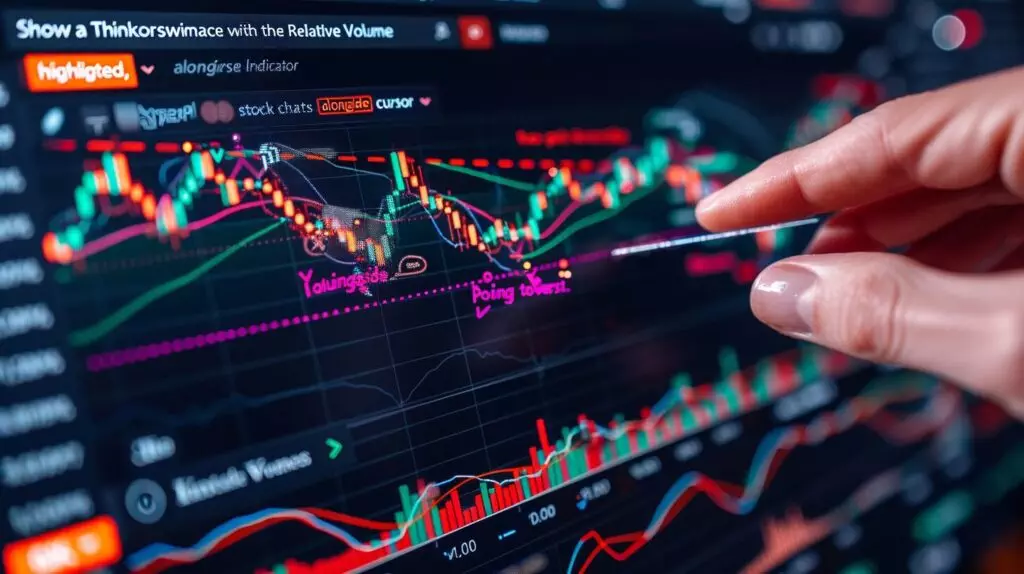Sometimes, trading can feel like navigating through a crowded bazaar. Amidst the hustle and bustle, we rely on the Thinkorswim trading platform as our guiding light. Of its many impressive indicators, the Relative Volume stands out. It acts as a compass, directing us towards trades that could potentially be profitable based on volume activity. But what exactly is it and what does it do?
This article, like many trading books, reveal the secrets of trading with the Relative Volume Thinkorswim.
Key Takeaways
- Relative volume is a measure of trading activity compared to the average volume of a stock.
- It helps in making informed trading decisions by identifying stocks with high relative strength.
- Thinkorswim scanners and scans tools compare current volume to average volume to determine the ratio, an indicator that tells us about the stock’s performance.
- High relative volume ratio on the tradingview platform indicates significant events or news that could affect the stock price.
Understanding the Concept of Relative Volume in Thinkorswim

Relative volume is a measure of trading activity that compares the current volume of a stock to its average. In Thinkorswim, this information coupled with time based volume data is vital in making informed trading decisions. The Thinkorswim scanners, chart studies, and the watchlist feature help us identify stocks with high relative strength, meaning they’re likely to outperform others in the market, even during extended hours.
These tools compare the current volume of a stock to its average volume, providing a ratio that indicates whether the trading volume is above or below the norm. A high relative volume ratio might suggest a significant event or news that could affect its price, demanding a revision of term trading strategies that work.
In addition to scanners and scans, chart studies and Thinkorswim columns let us monitor the relative volume over time, with an indicator that tells us about trends, and helping us make predictions about future performance.
How to Use the Relative Volume Indicator in Thinkorswim

The relative volume indicator, found in Thinkorswim chart studies, compares current trading volume to past trading volume over a particular period.
- Locating and Setting Up the Relative Volume Indicator: Navigate to ‘Studies’ on your Thinkorswim chart, then ‘Add Study’, and finally ‘All Studies’. Scroll down until you see ‘Relative Volume’. Click on it to add it to your chart.
- Understanding the Information Provided by the Indicator: The relative volume indicator displays a ratio. If the ratio is above 1, the current volume is higher than the average volume; below 1 indicates it’s lower.
- Using the Relative Volume Indicator to Make Trading Decisions: A high relative volume often signifies significant price movement, while a low relative volume might indicate a lack of interest in the security.
Advanced Features of the Relative Volume Indicator for Thinkorswim

The advanced features of the Relative Volume Indicator for Thinkorswim include color variations in the relative volume column and a time-based volume feature, which allows us to compare current volume with historical volume at the same time of day.
Thinkorswim also lets us adjust the settings according to our individual trading strategies, such as customizing the lookback period, which is the number of previous days that the system uses to calculate the relative volume.
The scanner feature is an essential part of Thinkorswim strategies. The scanner, adjustable to our opening range breakout strategy, allows us to sort through thousands of stocks based on our chosen criteria in Thinkorswim, making it easier to find potential trading opportunities.
Master the Relative Volume Scan in Thinkorswim

Mastering the Relative Volume Scan in Thinkorswim can be a game-changer for day traders who rely heavily on volume analysis. This Thinkorswim scan sifts through numerous stocks and pinpoints those with unusual trading volume, which is a telltale sign of potential significant price movement and it shows both open and the close volumes.
Best For: Day traders and investors who heavily rely on volume analysis in their trading strategy.
Pros:
- Identifies stocks with unusual trading volume, potentially indicating significant price movement.
- Helps in understanding investor sentiment: high relative volume and gap analysis suggest strong interest, low relative volume indicates lackluster sentiment.
- Applying the automatic supply and demand indicators in the tos platform can be a powerful tool in refining your trading strategy and spotting lucrative opportunities.
Cons:
- Implementing thinkorswim strategies requires a deep comprehension of volume analysis, which might be complex for beginners and hence there’s probably no need to rush.
Why is Relative Volume Important in Thinkorswim Trading and How Does it Compare to the Footprint Chart?
Relative volume is crucial in Thinkorswim trading as it compares the current trading volume to the average volume over a specific period. This helps traders identify potential breakout opportunities. On the other hand, the thinkorswim footprint chart provides a visual representation of the volume at each price level, allowing traders to analyze buying and selling pressure more effectively.
Exploring Easycators Thinkorswim Downloads for Relative Volume

Easycators Thinkorswim downloads for Relative Volume offer a user-friendly interface and provide real-time data, which is crucial in this fast-paced trading world. Once installed, you’ll see how Easycators coupled with the script for gap detection can significantly influence your trading decisions.
The features offer a clear picture of trading volumes relative to the historical average, aiding in identifying potential market trends. With Easycators Thinkorswim downloads for relative volume, coupled with thinkorswim strategies, you’re in a stronger position to maximize rewards, even during extended hours.
Conclusion
In conclusion, we’ve seen how the relative volume indicator in Thinkorswim can elevate our trading strategies. By understanding its concept, utilizing Thinkorswim features, mastering the scan and reading many of these classical Thinkorswim chart studies, we’ve gained a powerful tool.
Coupled with Easycators downloads, we’re now better equipped to make informed trading decisions.
So, let’s leverage these insights and navigate the financial markets with greater confidence. Remember, efficient indicators like relative volume are our allies in the trading arena.
Frequently Asked Questions
What is Relative Volume in Thinkorswim?
Relative Volume in Thinkorswim is a measurement of current volume compared to the average volume for the same time of day over a specified period. It helps traders identify unusual volume movements.
How can I use Thinkorswim chart studies with columns to analyze Relative Volume?
You can use Thinkorswim chart studies with columns to analyze Relative Volume by adding a time-based volume column to your chart studies. This allows you to visualize and analyze volume data more effectively.
What are some trading strategies that work well with Relative Volume in Thinkorswim?
Some trading strategies that work well with Relative Volume in Thinkorswim include intraday volume breakout strategies, momentum trading strategies based on volume spikes, and using Relative Volume as a signal for potential trend reversals.
Can Thinkorswim scanners and scans be used to identify Relative Volume opportunities?
Yes, Thinkorswim scanners and scans can be used to identify Relative Volume opportunities by setting up custom scans that filter for specific volume criteria, such as volume levels relative to the average for a given time frame.
What is the significance of time-based volume in relation to Relative Volume in Thinkorswim?
Time-based volume provides insight into how volume levels change throughout the trading day, allowing traders to identify specific time frames when Relative Volume tends to spike or drop, which can be helpful for making trading decisions.



